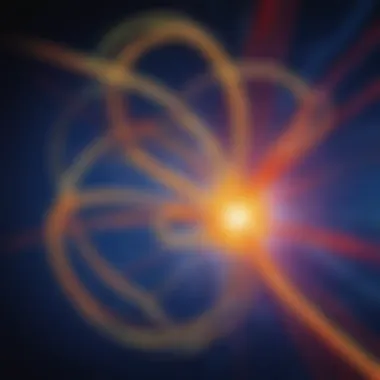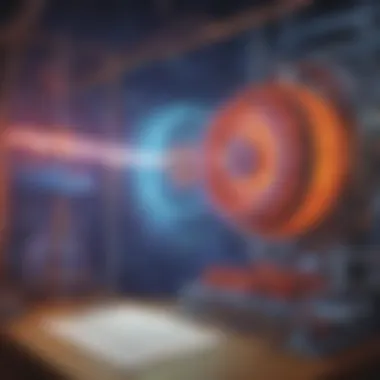Unraveling Fascinating Energy Transfer Experiments and Concepts


Science Fun Facts
Energy transfer is essential in numerous processes we encounter every day - from the ball rolling down a slope to the wind turning windmill blades 🌀. Understanding how energy transforms from one form to another unlocks the secrets of the universe around us.
Discover the Wonders of Science
Embark on a journey to uncover the magic of energy transfer through fascinating scientific concepts. By exploring the relationship between kinetic and potential energy, you will witness the incredible dance of energy in action. Dive into interactive learning tools that make complex scientific ideas easily understandable and applicable to real-life scenarios 🌌.
Science Quiz Time
Challenge yourself with brain-teasing puzzles and interactive quizzes designed to test your knowledge of energy transfer. Engage in gamified learning experiences that make science not only educational but also fun and rewarding. Are you ready to unravel the mysteries of energy through entertaining quiz sessions and thought-provoking questions?
Science Experiment Showcase
Prepare for a hands-on exploration of energy transfer with exciting experiments that showcase the beauty of scientific principles. Follow step-by-step instructions to conduct captivating demonstrations that elucidate the concepts of energy transformation. Ensure safety first by acquainting yourself with the materials list and incorporating proper precautions in every thrilling experiment ✨.
Introduction
Energy transfer experiments constitute a crucial aspect of scientific exploration, shedding light on the fundamental principles that govern the conversion and transmission of energy in various forms. This article embarks on a comprehensive journey delving into the nuances of energy transfer experiments, offering readers a profound understanding of the intricate mechanisms behind energy transformations.
Understanding Energy Transfer
Energy transfer serves as the cornerstone of numerous scientific endeavors, delineating how energy transitions from one form to another with astounding precision and efficiency. Within the realm of energy transfer, several key elements play pivotal roles in elucidating the dynamics of energy conversion and utilization.
Definition of Energy Transfer
At its core, the definition of energy transfer encapsulates the essence of energy transmutation, depicting the seamless transition of energy from one entity to another. This facet of energy transfer stands as a testament to the uni***** mutation capabilities of energy, highlighting its adaptability and versatile nature. The unique trait of energy transfer lies in its ability to catalyze transformations without diminishing its essence, fostering a continuous chain of energetic processes.
Importance in Physics
The significance of energy transfer in the realm of physics is unparalleled, serving as the foundational bedrock upon which all physical phenomena rest. Understanding the nuances of energy transfer in physics not only unveils the intrinsic workings of the universe but also empowers individuals to harness energy for various applications. The interplay between energy transfer and physics shapes our comprehension of the natural world, unveiling the interconnectedness of energy with all spatial entities.
Types of Energy


Energy manifests in multifarious forms, each exhibiting distinctive traits and behaviors that govern its interactions within different systems. Exploring the various types of energy provides a holistic perspective on the diverse manifestations of energy and their implicit roles in driving dynamic processes.
Kinetic Energy
Kinetic energy embodies the energy of motion, portraying the dynamic nature of objects in transit. The inherent characteristic of kinetic energy lies in its ability to fuel movement and instigate change, propelling objects along paths dictated by the force of motion. Within the scope of this article, the exploration of kinetic energy unveils its paramount role in animating physical entities and driving tangible transformations.
Potential Energy
Contrary to kinetic energy, potential energy epitomizes stored energy that awaits release under suitable conditions. The key essence of potential energy lies in its latent capacity to perform work once activated, depicting a reservoir of untapped energy awaiting liberation. Delving into potential energy illuminates the interconnectedness between stored energy and forthcoming actions that embody the essence of potentiality within physical systems.
Thermal Energy
Warmth and heat embody the essence of thermal energy, portraying the transfer of molecular agitation within systems. The distinctiveness of thermal energy rests in its ability to manifest as heat, fostering temperature differentials and driving thermal equilibrium within closed systems. Exploring thermal energy uncovers the nuanced role of heat in sustaining physical processes and facilitating energy exchange across diverse environments.
Chemical Energy
Chemical energy symbolizes the force contained within molecular bonds, wielding transformative power upon release. The essence of chemical energy lies in its capacity to fuel reactions and catalyze transformations that underpin biological and chemical processes. Investigating chemical energy elucidates the intricate dance of atoms and molecules, unraveling the intricate tapestry of chemical reactions that define the essence of energy transfer within molecular realms.
Basic Energy Transfer Experiments
In this section, we delve into the fundamental aspects of energy transfer experiments, shedding light on their significance in the context of our exploration. Basic Energy Transfer Experiments serve as the cornerstone in understanding the fundamental principles governing the transformation and exchange of energy. By engaging with these foundational experiments, readers can grasp the essence of energy transfer and its implications in various scientific contexts. Through a series of hands-on demonstrations, we aim to elucidate the core concepts surrounding energy transformation, emphasizing the interplay between different forms of energy.
Simple Pendulum Experiment
Materials Required:
The materials required for the Simple Pendulum Experiment play a pivotal role in facilitating a comprehensive understanding of pendulum dynamics and energy transfer. Key components such as a weight, string, and support structure are essential for constructing the pendulum apparatus. These materials are carefully selected to ensure optimal performance and precise measurements throughout the experimentation process. The unique characteristics of each material contribute to the overall efficacy of the experiment, enabling accurate observations and inferences regarding energy transfer mechanisms. Despite occasional imperfections, these materials remain popular choices due to their reliability and consistency in showcasing fundamental physics principles.
Procedure:
The procedural steps involved in the Simple Pendulum Experiment are meticulously designed to demonstrate the principles of oscillation and energy exchange within the system. From setting up the pendulum to executing controlled swings, each step is meticulously outlined to maximize the experimental outcomes. The procedure highlights the importance of consistency and accuracy in data collection, ensuring reliable results that align with theoretical expectations. By following the prescribed steps diligently, participants can explore the intricate relationship between potential and kinetic energy, gaining valuable insights into the dynamics of energy transfer.
Observations and Inferences:


The observations and inferences drawn from the Simple Pendulum Experiment offer profound insights into the behavior of oscillatory systems and energy conservation principles. By recording factors such as amplitude, period, and damping effects, participants can analyze the energy transformations occurring within the pendulum system. These observations guide researchers towards making informed inferences regarding the efficiency of energy transfer, ultimately enhancing their understanding of mechanical dynamics. While challenges may arise in data interpretation, the detailed observations yield substantial knowledge about the underlying mechanisms at play, fostering a deeper appreciation for energy transfer phenomena.
Spring Potential Energy Experiment
Setup Description:
A detailed setup description is paramount in conducting the Spring Potential Energy Experiment to its fullest potential. The arrangement of the spring, load, and measuring instruments defines the experimental dynamics, allowing participants to explore potential energy transformations effectively. The setup's unique features, such as the spring constant and displacement mechanisms, are crucial in quantifying energy changes and analyzing system behavior. Despite potential variations in setup configurations, a standardized approach ensures consistent results and facilitates comparative analyses across multiple trials. The setup description elucidates the experimental conditions essential for investigating the intricacies of potential energy storage and release.
Data Collection:
Efficient data collection procedures are integral to extracting meaningful insights from the Spring Potential Energy Experiment. Parameters like spring displacement, applied force, and resulting deformation are meticulously recorded to quantify potential energy variations accurately. The systematic collection of data points enables participants to detect trends, anomalies, and correlations associated with energy transfer processes. Emphasis is placed on precision and meticulousness during data acquisition, guaranteeing reliable datasets for subsequent analysis. By documenting data in a structured manner, researchers can unveil the nuances of potential energy dynamics and draw informed conclusions from their experimental findings.
Analysis of Results:
The analysis of results from the Spring Potential Energy Experiment elucidates the efficacy of data interpretation and theoretical concordance. By examining the relationship between applied force, spring deformation, and potential energy changes, researchers can derive fundamental equations governing the system's behavior. The detailed analysis sheds light on the efficiency of energy transfer mechanisms embedded within the spring system, offering a quantitative perspective on potential energy transformations. While uncertainties may arise in result interpretation, a meticulous approach to analysis ensures robust conclusions that underpin the fundamental principles of energy conservation. Through comprehensive result assessment, participants gain a deeper understanding of potential energy dynamics and their implications in practical scenarios.
Advanced Energy Transfer Demonstrations
In the context of this exploratory article on Energy Transfer Experiments, the segment dedicated to Advanced Energy Transfer Demonstrations holds a critical position. Advanced Energy Transfer Demonstrations present a leap forward in understanding the intricate mechanisms of energy exchange and transformation. This section encapsulates experiments that delve deeper into the complexities of energy transfer, elevating the comprehension of readers to a more profound level. By focusing on Advanced Energy Transfer Demonstrations, readers are exposed to sophisticated concepts and applications that are crucial for a comprehensive grasp of the subject matter. The inclusion of this section not only broadens the scope of the article but also provides a bridge to more intricate facets of energy transfer.
Electric Circuit Experiment
Components Needed: The core essence of the Electric Circuit Experiment lies in the precision and compatibility of the components used. Among the crucial components are resistors, capacitors, and diodes, showcasing distinctive functionalities in circuit operations. The selection of these components is paramount, as it directly influences the performance and outcomes of the experiment. Emphasizing the quality and suitability of these components contributes significantly to the success of the experiment. Their unique properties, such as resistance values and capacitance ratings, determine the behavior of the circuit and highlight their vital role in achieving accurate results.
Circuit Construction: The construction phase of the circuit is equally pivotal in ensuring the experiment's efficacy. The arrangement of components, design of circuit boards, and wiring connections demand meticulous attention to detail. The layout should follow a logical sequence, considering signal flow and operational stability. The efficiency and reliability of the circuit rely heavily on the construction methodology employed. By elucidating the nuances of circuit construction, readers gain a profound insight into the structural backbone of the experiment and its significance in generating reliable data.
Voltage and Current Analysis: Voltage and current analysis serve as the linchpin of the Electric Circuit Experiment, facilitating a comprehensive assessment of energy flow and distribution within the circuit. Analyzing voltage drops across components and measuring current levels contribute to understanding the circuit's behavior under varying conditions. The precision and accuracy of these measurements are crucial in drawing valid conclusions from the experiment. By conducting thorough voltage and current analysis, readers can decipher the intricate relationships between different circuit elements and grasp the fundamental principles of electrical energy transfer.
Solar Energy Capture Project
Design Planning: The cornerstone of the Solar Energy Capture Project rests on meticulous design planning that integrates various elements to harness solar energy efficiently. Factors such as solar panel orientation, tracking systems, and energy storage solutions define the success of the project. Designing an optimal framework that maximizes energy absorption and utilization is imperative for achieving sustainable outcomes. The unique feature of comprehensive design planning lies in its ability to amalgamate solar technologies and strategies seamlessly, creating a cohesive structure for effective energy capture.
Implementation Steps: Implementing the Solar Energy Capture Project involves a series of systematic steps aimed at translating design concepts into functional reality. Installation of solar panels, setup of monitoring equipment, and configuration of energy management systems constitute integral implementation processes. Each step contributes to the project's viability and operational efficiency, paving the way for successful energy conversion. Detailing the implementation steps offers readers a roadmap to follow, ensuring a streamlined execution of the solar energy project.


Performance Evaluation: The evaluation phase of the Solar Energy Capture Project encompasses rigorous assessment and analysis of energy generation and utilization metrics. Monitoring energy output, tracking system efficiency, and assessing overall performance indicators are critical aspects of performance evaluation. By scrutinizing key performance parameters, readers can gauge the effectiveness and sustainability of the solar energy project. The unique feature of performance evaluation lies in its ability to quantify the project's impact and efficiency, providing valuable insights for future enhancements and optimizations.
Real-Life Applications of Energy Transfer
In this section, we delve into the practical applications of energy transfer principles in real-world scenarios. Understanding how energy conversion plays a crucial role in our daily lives provides us with valuable insights into the functioning of various processes and machinery. Exploring the applications of energy transfer allows us to grasp the significance of energy in different forms and how it impacts our surroundings and activities.
Energy Conversion in a Car Engine
Combustion Process
The combustion process is a fundamental aspect of energy transfer within a car engine. It involves the ignition and burning of fuel to generate power for the vehicle. The combustion process is vital as it is responsible for transforming the potential chemical energy stored in the fuel into kinetic energy that propels the car forward. One of the key characteristics of the combustion process is its efficiency in converting fuel into mechanical energy, making it a popular choice for powering internal combustion engines. Despite its effectiveness, the combustion process also poses environmental challenges due to the release of emissions, highlighting the need for sustainable energy practices.
Mechanical Energy Generation
Mechanical energy generation is another crucial element in the energy transfer dynamics of a car engine. As the pistons move and the crankshaft rotates, mechanical energy is produced, driving the various components of the vehicle. The key characteristic of mechanical energy generation lies in its direct contribution to the movement and functionality of the car, showcasing its effectiveness in powering automotive systems. While mechanical energy generation is essential for vehicle operation, it also generates heat and mechanical wear, influencing engine longevity and maintenance requirements.
Efficiency Considerations
Efficiency considerations play a significant role in optimizing energy transfer within a car engine. Ensuring that the energy from the fuel is maximized and utilized effectively is essential for enhancing the vehicle's performance. The key characteristic of efficiency considerations lies in improving fuel economy and reducing emissions, making it a beneficial choice for eco-conscious drivers. Despite its advantages, efficiency considerations may lead to trade-offs between power output and environmental impact, highlighting the need for continuous advancements in automotive technology to balance energy efficiency and ecological sustainability.
Conclusion
The Conclusion section of this article sits as the pinnacle of our discourse on energy transfer experiments. It serves as the culmination of all the knowledge imparted within the preceding sections; it encapsulates the essence of energy transfer's significance in the realms of physics and real-world applications. Through a meticulous unraveling of complex concepts, the Conclusion provides a seamless transition from theoretical understanding to practical implications. It underscores the importance of comprehending energy transfer not just as a scientific theory but as a fundamental principle that governs our everyday interactions with energy sources, creating bridges between abstract ideas and tangible experiences. The intricacies of energy transfer mechanisms are laid bare, inviting readers to delve into a world where potential can transform into kinetic, and where thermal energy can drive engines forward. As we navigate through the maze of energy conversions, the Conclusion stands as a guiding light, illuminating the paths toward a more profound appreciation of the forces at play in our universe.
Key Learnings
Recap of Energy Transfer Concepts
Within the Key Learnings section of this article, we confront the crux of energy transfer concepts. The Recap of Energy Transfer Concepts serves as a pivotal axis around which our understanding of energy dynamics revolves. It encapsulates the fundamental principles that govern the transformation of energy from one form to another, offering a succinct yet comprehensive overview of the intricate web of energy interplay. The innate flexibility of Recap allows us to distill complex theories into digestible nuggets of information, enabling a deeper engagement with the underlying mechanisms of energy transfer. Its adaptability to various scenarios within the energy transfer domain makes Recap a versatile tool, capable of bridging gaps between theoretical knowledge and hands-on experimentation. The distinctive feature of Recap lies in its ability to synthesize diverse energy concepts into a cohesive narrative, empowering readers to grasp the essence of energy transfer with clarity and precision.
Impact on Everyday Life
Transitioning to the Impact on Everyday Life segment, we delve into the pragmatic repercussions of energy transfer in our daily existence. This facet of the article shines a light on how energy transfer concepts permeate every aspect of our lives, from the ignition of a car engine to the illumination of our homes. The inherent practicality of Impact on Everyday Life underscores the ubiquitous nature of energy conversions, emphasizing their crucial role in sustaining modern civilization. By elucidating the connections between abstract energy theories and tangible applications, Impact on Everyday Life bridges the gap between classroom knowledge and real-world scenarios, fostering a deeper appreciation for the omnipresence of energy dynamics. Its ability to contextualize energy transfer within the fabric of daily routines heightens the reader's awareness of the invisible yet omnipotent forces that shape our interactions with the physical world.
Future Exploration
In the realm of Future Exploration, we peer into the horizons of innovation within energy transfer studies. Addressing the Innovations in Energy Transfer Studies, we uncover the cutting-edge developments that hold the potential to revolutionize energy dynamics. The relentless pursuit of efficiency and sustainability drives the evolution of energy transfer methodologies, propelling us towards a future where energy utilization is optimized and environmental impact minimized. The key characteristic of Innovations lies in their transformative capacity, paving the way for novel approaches to energy management and utilization. By spotlighting the groundbreaking advancements in energy transfer studies, Innovations inspire a sense of awe and potential, prompting us to reimagine the limits of energy conservation and utilization.
Technological Advancements
Shifting our focus to Technological Advancements, we unravel the tapestry of innovation that propels energy transfer into new frontiers. The hallmark of Technological Advancements lies in their seamless integration of theory and practice, bridging the gap between conceptual frameworks and tangible outcomes. By harnessing the power of technology, advancements in energy transfer studies have ushered in an era of unprecedented precision and efficiency, offering solutions to age-old challenges in energy management and conservation. The unique feature of Technological Advancements lies in their adaptability and scalability, enabling the implementation of energy transfer solutions across a myriad of industries and applications. As we embrace the transformative potential of technological advancements, we embark on a journey towards a more sustainable and energy-efficient future.







